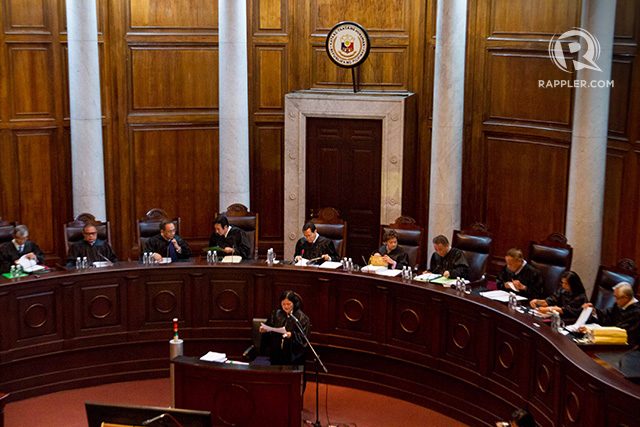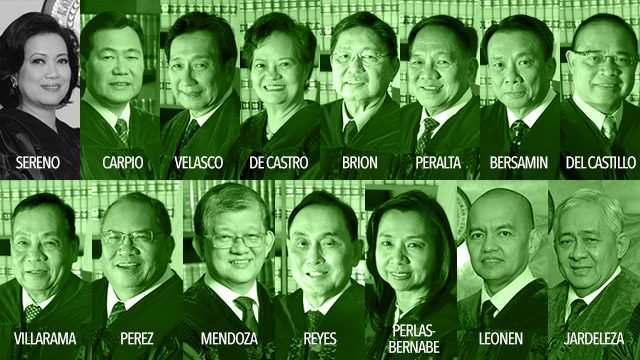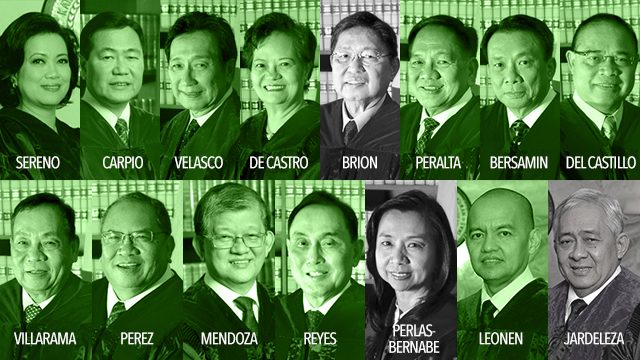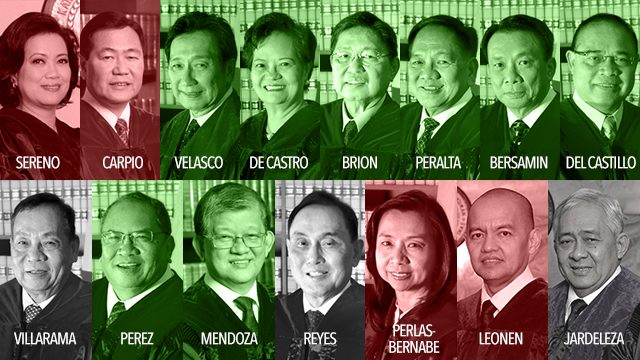SUMMARY
This is AI generated summarization, which may have errors. For context, always refer to the full article.

MANILA, Philippines – From electoral and political cases to environmental concerns, the Supreme Court has crafted landmark rulings that will affect policy-making and set precedents for future legal issues.
Let’s look back at some of these major decisions by this batch of justices of the SC – released between the latest appointment to the High Court of Associate Justice Francis Jardeleza in August 2014, and Associate Justice Martin Villarama Jr’s early retirement on January 16, 2016.
The members of this batch are Chief Justice Maria Lourdes Sereno, Senior Associate Justice Antonio Carpio, and Associate Justices Presbitero Velasco Jr, Teresita Leonardo-De Castro, Arturo Brion, Diosdado Peralta, Lucas Bersamin, Mariano del Castillo, Villarama, Jose P. Perez, Jose C. Mendoza, Bienvenido Reyes, Estela Perlas-Bernabe, Marvic Leonen, and Jardeleza.
Among the decisions released during this period, all 15 judges issued unanimous decisions in only two, both of which concern the Commission on Elections (Comelec).
Meanwhile, in 4 cases, the majority decision was concurred in by only 7 or 8 justices.
In decisions where not all 15 justices voted – when some inhibited or were on leave – the High Court generally voted with no dissenting vote.
The most recent addition to the SC, Justice Jardeleza, recused or did not take part in voting in many of these decisions because he was former Solicitor General. In that capacity, he acted as counsel, or was part of counsel for government, in cases prior to his appointment to the High Court.
The vote breakdown per decision should be interpreted as follows: the first number counts justices who concurred; the second, the number who dissented; and the third, the number of justices who inhibited or took no part in the vote.
Click on the “Previous” button to read the summary of the decision before it, and the “Next” button to read the summary of the decision after it, and view the justices’ votes.
For mobile users, you may also swipe left or right to see the previous or next decision.
| Legend: |
Concurred | Dissented | Inhibited/No Part |

Campaign ads airtime limit
September 2, 2014
Vote: 14-0-1
The SC struck down a resolution by the Commission on Elections (Comelec) that limited the airtime of TV and radio advertisements by candidates during the campaign period.
The High Court reverted the rule to 120 minutes per TV station and 180 minutes per radio station, instead of 120 minutes across all TV stations and 180 minutes across all radio stations.
Read the SC decision here.

Compensation for Tubbataha damage
September 16, 2014
Vote: 13-0-2
The SC junked a petition for a writ of kalikasan (nature) in connection with a US Navy ship running aground in Tubbataha Reef in January 2013. The petition was filed by environmental activists and leftists groups led by Palawan Bishop Pedro Arigo.
The SC ruled that the damages provided by the writ “are to be made in a separate civil suit” or “with any criminal action,” which it likewise refused to order, saying it has no jurisdiction over the matter. The court also deferred the matter of seeking compensation for damages to President Benigno Aquino III.
In February 2015, the United States paid the Philippines P87 million ($2 million) in compensation, after the US embassy negotiated directly with the Philippine government.
Read the SC decision here.

Ong dismissed as Sandiganbayan justice
September 23, 2014
Vote: 8-5-2
Voting 8-5-2, the Supreme Court dismissed Sandiganbayan Justice Gregory Ong due to his links to alleged pork barrel scam mastermind Janet Lim-Napoles.
The dismissal order against Ong was “immediately executory”, said the SC, after it took into serious consideration the testimonies of pork barrel scam whistleblowers Benhur Luy and Marina Sula. Rappler, in August 2013, also exposed Ong’s links to Napoles through a photo of him with Napoles and Senator Jinggoy Estrada.
The justices who dissented, however, noted that Ong’s transgressions were tantamount “only to simple misconduct.”
Read the majority decision here. Read also the concurring opinions of Justices Brion, Jardeleza, and Leonen; and the concurring and dissenting opinions of Justices Bersamin, Perez, and Reyes.

Transfer of Pandacan oil depot
November 25, 2014
Vote: 10-2-3
The SC declared unconstitutional and invalid Ordinance Number 8187 of the City of Manila, which allowed the Pandacan oil depot to stay in its present location.
It then ordered the relocation and transfer of the oil distribution terminals of Pilipinas Shell, Caltex, and Petron, resolving an environment and security concern that 3 administrations failed to address over more than a decade.
Read the majority decision here. Read also the concurring and dissenting opinion of Justice Leonen.

Disqualification of Laguna Governor ER Ejercito
November 25, 2014
Vote: 12-0-3
In a unanimous decision, the SC upheld the Comelec ruling disqualifying Laguna Governor Emilio Ramon “ER” Ejercito for overspending during the 2013 midterm elections.
Allowed by law to spend only P4.5 million for his campaign, Ejercito reported expenses of P6 million in political advertisements alone.
Read the SC decision here.

Team Patay/Team Buhay tarps
January 21, 2015
Votes: 9-5-1
The SC sided with the Diocese of Bacolod in allowing it to hang “Team Buhay”/”Team Patay” tarpaulins outside a Bacolod City church during the 2013 elections.
Through the tarpaulins, the diocese campaigned against senatorial candidates who supported the reproductive health (RH) law and endorsed those who opposed the measure.
The High Court ruled that the Comelec’s order to take down the tarpaulins was unconstitutional, saying that it violated the church’s right to free speech, expression, and property.
Read the majority decision here. Read also the separate concurring opinions of Justices Carpio and Perlas-Bernabe, and the dissenting opinion of Justice Brion.

Estrada’s disqualification junked
January 21, 2015
Votes: 11-3-1
The SC dismissed the disqualification case against former president and now Manila Mayor Joseph Estrada, saying he was eligible to run for the 2013 elections.
The High Court upheld a Comelec decision dismissing the petition filed by lawyer Alicia Vidal. While Estrada was convicted of plunder by the Sandiganbayan, the SC ruled that the pardon subsequently granted to him by then president Gloria Macapagal Arroyo in 2007 restored his civil and political rights.
Read the majority decision here. Read also the separate opinion of Justice Brion, the concurring opinion of Justice Mendoza, and the dissenting opinion of Justice Leonen.

Jinggoy Estrada’s plea vs plunder case
January 21, 2015
Votes: 9-5-1
The SC denied Senator Jinggoy Estrada’s plea to junk the plunder and graft charges filed against him in connection with the pork barrel scam.
In his petitions, Estrada said this “procedural violation” prevented him from exercising his right to answer the complaints against him. But the SC ruled that Estrada failed to prove his argument.
Read the majority decision here. Read also the dissenting opinions of Justices Brion and Velasco, and the concurring opinion of Justice Leonen.

Partial reversal in DAP decision
February 3, 2015
Votes: 13-0-2
While affirming its July 2014 decision on the unconstitutionality of two executive acts in relation to the Disbursement Acceleration Program (DAP), the SC partially granted the government’s motion to reverse its ruling on the 3rd executive act pertaining to the funding of projects that were not covered by any appropriation in the national budget.
“There is no requirement in the Constitution or the General Appropriations Act (GAA) that the subject of augmentation should be the expense category or allotment class” and that what is required is only for Congress to create items to comply with the line-item veto of the president, explained SC spokesperson Theodore Te.
Read the SC decision here. Read also the separate opinions of Justices Carpio and Brion, the concurring and dissenting opinion of Justice Del Castillo, and the concurring opinion of Justice Leonen.

Cudia vs PMA
February 24, 2015
Vote: 13-0-2
The SC upheld the ruling of the Philippine Military Academy (PMA) in dismissing a graduating cadet for violating the school’s honor code.
Cadet Aldrin Jeff Cudia was deemed to have lied about his explanation for his tardiness in one class. He was supposed to graduate with honors in March 2014.
Read the SC decision here.

Comelec-Smartmatic deal
April 21, 2015
Vote: 15-0
In a unanimous decision, the SC nullified the extended warranty contract between the Comelec and Smartmatic-Total Information Management (TIM) for the diagnostics of the PCOS machines that will be reused in the 2016 national elections.
The Comelec failed to justify the P286-million contract without public bidding, the High Court said.
Read the SC decision here. Read also the concurring and dissenting opinion of Justice Velasco.

Oil exploration in Tañon Strait
April 21, 2015
Vote: 14-0-1
Environmentalists secured a victory when the SC ruled in their favor and stopped oil exploration, development, and exploitation of petroleum resources within Tañon Strait, a protected seascape in the Visayas known for its abundance in whales and dolphins.
The SC nullified the service contract that the Department of Energy (DOE) awarded to Japan Petroleum Exploration Co Ltd (Japex) for oil exploration and drilling. It cited the DOE’s failure to comply with the safeguards under the Constitution.
Read the SC decision here. Read also the concurring opinion of Justice Leonen.

Torre de Manila construction TRO
June 16, 2015
Vote: 8-5-2
The SC issued a temporary restraining order (TRO) on the construction of the controversial Torre de Manila condominium, which culture advocates have slammed for destroying the view of the historic Rizal Shrine in the nation’s capital.
The High Court then set up oral arguments to hear petitioner Order of the Knights of Rizal and respondent DMCI Homes, which constructed the condominium.

Quezon City garbage fees
June 30, 2015
Vote: 12-0-3
The SC deemed unconstitutional an ordinance of Quezon City which collects a garbage tax of P100 to P500 a year from households and penalizes those who refuse to pay.
It also ordered the Quezon City government to refund the fees it had collected before the 2013 ordinance was temporarily stopped in 2014.
Read the SC decision here.

Enrile bail granted
August 18, 2015
Votes: 8-4-3
The SC granted bail to Senator Juan Ponce Enrile, who is among those implicated in the pork barrel scam. The justices who voted in favor of Enrile granted his request based on humanitarian grounds, but one of the dissenting justices said that the ruling was a “special accommodation” for him.
The 91-year-old Enrile, who had been in hospital arrest for over a year, posted the P1.45-million bail before the Sandiganbayan two days after the SC decision.
Read the majority decision here. Read also the dissenting opinion of Justice Leonen.

Piatco compensation
September 8, 2015
Votes: 10-0-5
The SC ordered the government to pay Philippine International Air Terminals Company (Piatco) $510.3 million in just compensation for the takeover of the Ninoy Aquino International Airport Terminal 3 (NAIA-3).
Manila’s largest airport terminal had been the subject of a legal dispute since the Philippine government seized it in 2004, citing breach of contract and failure to conform with safety standards.
Read the SC decision here.

Arroyo plunder case stopped
October 20, 2015
Votes: 12-0-3
In a resolution, the SC halted for 30 days via a status quo ante order (SQAO) the proceedings of the Sandiganbayan on the plunder case filed against former President Gloria Macapagal-Arroyo.
She is facing charges for having approved the use of P365.9 million in Philippine Charity Sweepstakes Office (PCSO) funds which were allegedly misused from 2008 to 2010.
When the SQAO expired, the SC extended it for 90 days, or until February 2016. Arroyo cited, among others, the findings of the United Nations Working Group on Arbitrary Detention, which said that her continued hospital detention “violates international law” and is “arbitrary on a number of grounds.”

Mayor Binay vs Ombudsman
November 10, 2015
Votes: 10-0-5
The SC upheld the power of the Court of Appeals (CA) to review and stop orders issued by the Ombudsman to elected officials. This was in connection with the Ombudsman’s suspension of Makati City Mayor Jejomar Erwin “Junjun” Binay Jr.
The Ombudsman slapped Binay with his first 6-month suspension order in March over his alleged involvement in the overpricing of the controversial Makati City Hall parking building. He ran to the CA, which granted Binay a TRO, then took back the reins of city hall from acting mayor Romulo Peña.
In June, Binay was slapped with a second suspension order. The mayor once again went to the CA to block the move, but the Ombudsman eventually ruled against him in October in its probe on the parking building project. Binay was dismissed and removed from office, and vice mayor Peña was sworn in as mayor.

Condonation doctrine abandoned
November 10, 2015
Votes: 7-3-5
In the same decision on Mayor Binay’s case, the SC decided to abandon the condonation doctrine in future cases.
The said doctrine – which Binay cited in his defense – absolves an official of administrative liability committed while he or she was in office if that official is reelected.
Read the majority decision for this and for the preceding item here. Read also the concurring and dissenting opinion of Justice Bersamin.

Bt talong and GMO field testing
December 8, 2015
Votes: 12-0-3
The SC permanently stopped the field testing for Bt (Bacillus thuringiensis) talong (eggplant), upholding a decision of the Court of Appeals (CA) which stopped the field trials for the genetically modified eggplant. The CA ruled that the said field trials violate the people’s constitutional right to a “balanced and healthful ecology.”
The High Court also temporarily stopped any application for field testing, contained use, propagation, and importation of genetically modified organisms (GMOs), pending the promulgation by the Department of Agriculture of a new administrative order in accordance with the law.
Read the SC decision here. Read also the concurring opinions of Justices Velasco and Leonen.

‘No Bio, No Boto’ policy
December 16, 2015
Votes: 15-0
The petition to declare the Comelec’s “No Bio, No Boto” (no biometrics, no vote) policy unconstitutional was junked unanimously by the SC for lack of merit.
The SC upheld the Comelec’s intent to cleanse the voters’ list through this policy, which was in accordance with Republic Act 10367.
Read the SC decision here. Read also the concurring opinion of Justice Leonen.

EDCA constitutional
January 12, 2016
Votes: 10-4-1
The SC declared constitutional the Enhanced Defense Cooperation Agreement (EDCA) entered into by the Philippines and the United States in 2014.
Petitioners argued that it needed to be ratified by the Senate first. But the SC agreed with Malacañang in its argument that EDCA is an executive agreement and does not need the Senate’s concurrence.
The military deal gives US troops, planes, and ships increased rotational presence in Philippine military bases, and allows Washington to build facilities to store fuel and equipment there.
Read the majority decision and the separate concurring opinion of Justice Brion here. Read also the dissenting opinions of Justices Brion and Leonen, and the concurring and dissenting opinion of Justice Leonardo-De Castro here.

Grace Poe’s candidacy
January 12, 2016
Votes: 12-3
Racing against time during the Christmas holidays, Senator Grace Poe secured from the SC a temporary restraining order (TRO) on the cancellation by the Comelec of her certificate of candidacy (COC) due to citizenship and residency issues.
The SC, voting 12-3, affirmed the TROs issued by Chief Justice Maria Lourdes Sereno in December. With oral arguments set on January 19 and the Comelec set to prepare the layout of the ballots, this means Poe’s name will remain on the list of candidates for president. – Rappler.com
Add a comment
How does this make you feel?
There are no comments yet. Add your comment to start the conversation.